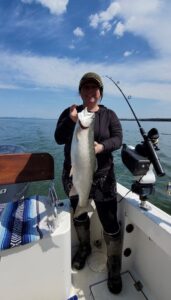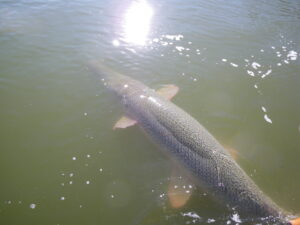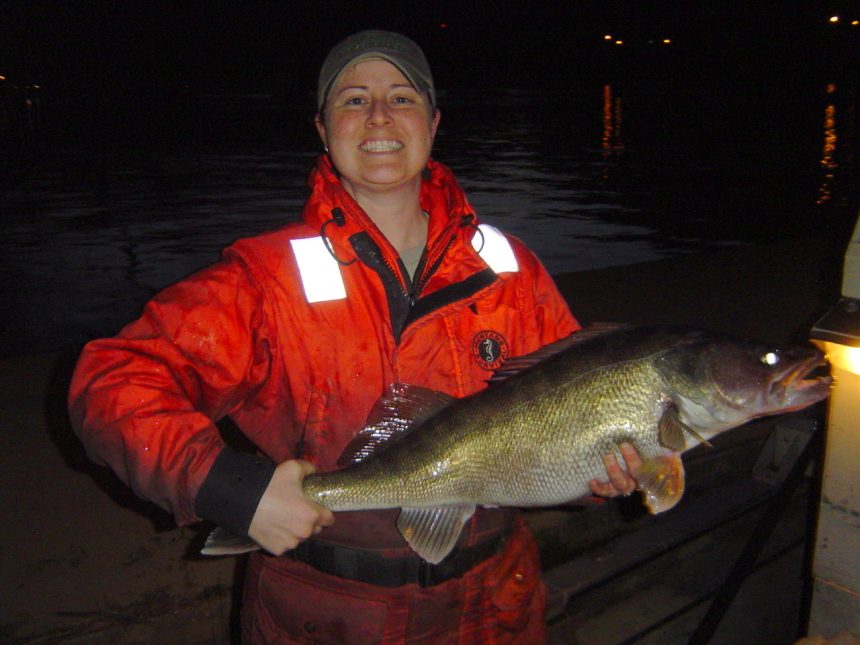By Tim Allard
Title image: West Virginia Division of Natural Resources Fisheries Biologist Katie Zipfel holds a walleye from West Virginia’s native strain. Genetic research and stocking of these native walleye are enabled by Sport Fish Restoration funding. Courtesy West Virginia Division of Natural Resources.
Since 1950, excise taxes paid by fishing equipment manufacturers have been an essential tool for state fisheries biologists to conserve healthy fish populations and habitat, and increase angler access to millions of acres of fishable water. This successful conservation partnership exists because of the Sport Fish Restoration (SFR) Act. The legislation directs taxes paid by fishing equipment manufacturers and taxes on motor boat fuel to the U.S. Fish and Wildlife Service (USFWS), which then administers these funds as SFR grants to state fish and wildlife agencies.
As a result of SFR funding, state biologists can take advantage of cutting-edge technology and other resources to better understand and manage fisheries. Nowhere is this more true than the insights gained from the highly specialized field of genetics. Below is a look at how genetic assessments of hatchery-raised fish and genetic study of natural fish populations are helping conserve and manage sport fish populations to benefit anglers and the fishing industry alike.
Lake Champlain Steelhead

Beginning in 2002, Vermont’s Fish & Wildlife Department (VFWD) used SFR funding to complete a five-year hatchery assessment and a six-year field evaluation, comparing two different strains of steelhead in order to maximize fish survival and angling opportunities on Lake Champlain. At the time of, and prior to, the evaluation, VFWD was stocking the Memphremagog strain into Champlain, while New York’s Department of Environmental Conservation was stocking the Chambers Creek strain.
Using funding derived from fishing industry paid excise taxes and the motor boat fuel tax, VFWD assessed the strains by doing side by side comparisons within the hatchery. Upon stocking as smolts, differential external marking techniques were used to determine results during angler surveys and fisheries assessments of the number of fish of each strain caught by anglers or returning to tributaries in the Champlain basin.
“[The Memphremagog strain] was doing well on tributaries of Lake Memphremagog in Vermont within the Northeast Kingdom, but here in Lake Champlain the Chambers Creek fish had done much better during the strain evaluation, so then we switched primarily to all of those for smolt stocking,” said Kevin Kelsey, Facility Manager at VFWD Ed Weed Fish Culture Station.
Vermont’s stocking the strain more suited for performing in the Lake Champlain basin is good news for both fishing equipment manufacturers and anglers. Chambers Creek steelhead provide a better return on investment with respect to fish production and steelhead catch rates. This, in turn, creates more and better fishing opportunities, which potentially may grow angler participation and spending.
Another success was VFWD’s foresight to collect parr samples from 120 Chambers Creek steelhead in 2007. This allows the VFWD Fisheries Division to maintain a genetically diverse population, using multiple year classes of captive broodstock adult steelhead to support at least two decades or more of stocking into Lake Champlain.
“It’s just awesome to be able to make a difference for fisheries for the people of Vermont and everyone who wants to enjoy what we do here in this state, and we couldn’t do it without the [SFR] funding,” Kelsey said.
West Virginia Walleye
The excellent walleye fishing on the New River is another success story for fishing tackle manufacturers and anglers. It began two decades ago when West Virginia’s Division of Natural Resources (WVDNR) used SFR funds to conduct genetic assessments of walleye. Biologists wanted to determine whether a local, native strain existed and, if so, whether it might be more productive for stocking than Lake Erie sourced walleye, which was WVDNR’s existing existing approach.
Tissue samples from across West Virginia revealed a native strain of walleye within the upper Kanawha River, New River, and the upper Ohio River. The strain was also detected in a smattering of smaller rivers and in some lakes.
“Once we found that out… we decided that we could in fact propagate this strain in our hatcheries and we decided it was important to do so,” said Katherine Zipfel, a WVDNR Fisheries Biologist. “We assumed native, riverine walleye would have riverine adapted characteristics that might make it more successful in our waters than stocking fish from Lake Erie, so we decided that would be beneficial to us and our fisheries.”
WVDNR then developed a walleye management plan specific to stocking of the native strain. It prioritized stocking in the New and Kanawha rivers watershed, which began around 2005.
“We didn’t have great walleye fisheries before then and now we have excellent walleye fisheries,” Zipfel said. “We get a lot of out-of-state anglers commenting on how good the New River is, for example, or how good Summersville Lake is, or how good some of our Ohio River tailwater fisheries are, so we know for sure the stocking was successful.”
The genetics work involved in screening walleye for fish production at the hatchery, as well as ongoing population studies, demonstrate increases of native strain of walleye in West Virginia’s waters. This impressive result, along with the incredible walleye angling opportunities created from stocking native fish would not have been possible without fishing manufacturer paid excise taxes and the motor boat fuel tax.
“Almost 100 percent of these activities were funded by Sport Fish Restoration dollars,” Zipfel said. “Getting this kind of funding to be able to do state-wide projects like this is incredibly beneficial.”
Looking to the future, WVDNR has plans to undertake a project in collaboration with West Virginia University. The study will use the latest genetics techniques to investigate whether walleye stocking is affecting genetic diversity within fish populations and explore opportunities for improving the state’s walleye fishery.
Texas Alligator Gar
Texas is home to a world-class alligator gar fishery, which supports a flourishing guide industry and attracts approximately 100,000 anglers annually. Growing angler interest in catching one of North America’s largest freshwater fish weighing over 200 pounds, and subsequent spending, benefits fishing tackle manufacturers. In order to effectively manage this important fishery, Texas’ Parks and Wildlife Department (TPWD) is using SFR funds to conduct research and learn more about alligator gar, which, until recently, little was known.

Recently, TPWD utilized funding to undertake a study analyzing genetic markers to better understand alligator gar populations. Results revealed three lineages of alligator gar across its distribution range. The findings were based on fish samples from Texas as well as samples from other states provided by Brian Kreiser with the University of Southern Mississippi.
“There’s one [lineage] that’s widespread across the geographic range, there’s another one that’s restricted to coastal areas, and a third lineage that is restricted to southern Texas,” said TPWD Natural Resource Specialist Damon Williford.
Findings also showed substantial genetic differentiation between alligator gar from different regions of the state. This has given TPWD a better understanding of how these fish disperse and move around.
The study’s results may also have implications for other states stocking alligator gar, suggesting possible benefits for raising fish intended for stocking from nearby gar populations experiencing similar environmental conditions. This echoes WVDNR’s rationale for stocking a native walleye strain versus one from Lake Erie.
“Mostly, what the genetics work has helped us understand is what are manageable populations,” said David Buckmeier, Inland Fisheries Research Program Director with TPWD. “It is influencing our directions and what we’re thinking for future management.”
Thanks to fishing manufacturer paid excise taxes and the motor boat fuel tax, TPWD has successfully conducted genetics research, along with telemetry studies and other life history and ecological studies, to better understand alligator gar populations. TPWD is currently using these data to determine the best management approaches to protect and maintain Texas’ unique alligator gar fisheries, and ensure there are plenty of large, recreationally valuable fish for anglers to catch.
These SFR-funded conservation efforts are especially critical for alligator gar. These long-lived, top predators are particularly susceptible to over harvest and spawning habitat loss, which can quickly cause alligator gar populations to decline. And, once the damage is done, restoring alligator gar numbers can take decades.
The genetics work showcased above are just a few examples of how SFR funds, derived from fishing manufacturer paid excise taxes and motor boat fuel tax, are enabling state biologists to use cutting-edge technology to understand and effectively manage fish populations. This, in turn, increases public angling opportunities, which have the potential to increase participation and angler spending on fishing tackle, boats, and boating accessories.

